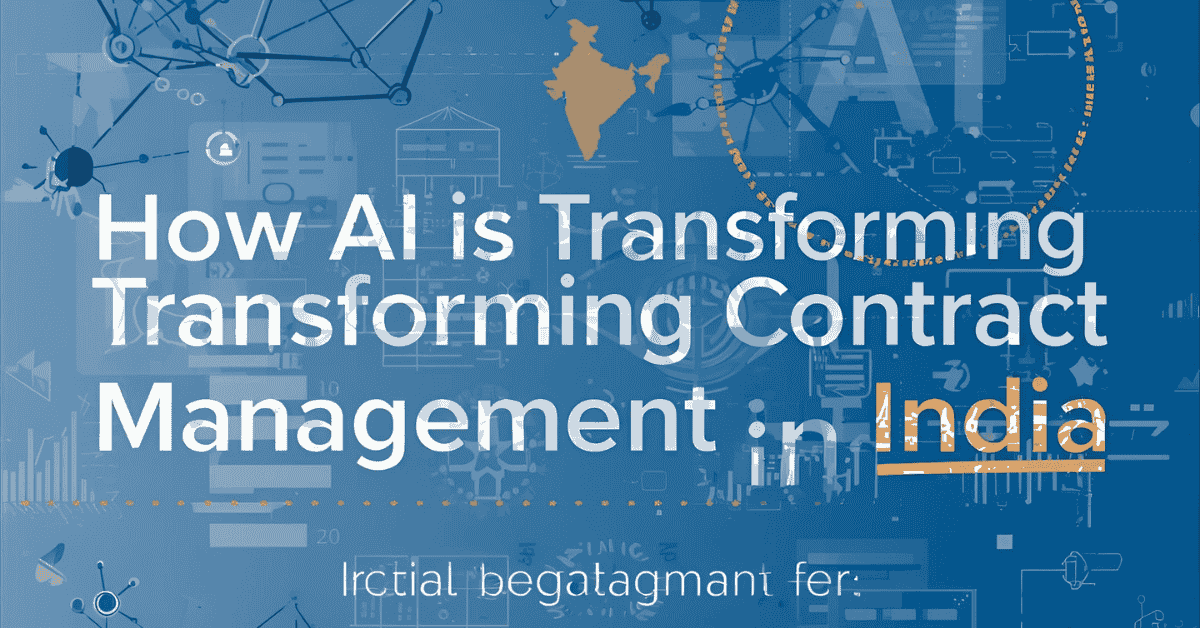Indian companies lose billions of rupees in hidden value each year because of how they manage their contracts. Scattered files, email chains, and manual processes may seem manageable, but the inefficiencies compound into serious financial loss.
Studies show that bad management and missed obligations cost businesses about 8.6 percent of the value of their contracts. The ability of contract lifecycle management (CLM) systems to reduce these losses is driving rapid adoption.
The CLM market in India was worth $298.88 million in 2024. It is expected to grow steadily at the rate of 14.51% per year and reach a valuation of $1,011.78 million by 2033.
The takeaway for leaders is clear: without stronger systems, their enterprises will continue to see significant erosion of contract value.
Why Indian Enterprises Struggle With Contracts
Even though more and more Indian businesses are using digital tools, contract management is still a weak point for many of them. The result is slower execution, more risk, and a steady loss of contract value. The key problems are:
- Fragmentation and siloed data
Even though 73 percent of medium and large Indian firms have digitized CLM, many still run disconnected systems for drafting, approvals, and storage. This fragmentation forces legal teams to reconcile versions manually and leaves leaders without a single source of truth.
- Rising volumes and complexity in renewal
As enterprises expand, contract portfolios multiply. As businesses grow, they execute more contracts. Their renewals, escalation clauses, amendments, and cross-dependencies add multiple layers of complexity. Keeping track of them takes a lot of time and effort without automation. Companies that have gone digital say their processing costs are up to 45% lower.
- Loss of value during negotiations
Without access to analytics or benchmarking, legal and procurement teams often agree to terms that are unfavourable for them. Each of these may seem small individually, but when you add the concessions provided across hundreds, sometimes thousands, of contracts, the loss of value is huge.
India’s regulatory environment is ever-changing. New laws on data protection, taxation, procurement rules, etc. are introduced every year, and existing rules get changed or abolished. Without having a centralized oversight facility, enterprises will have difficulty in managing their contract portfolios, and run into compliance issues.
- Delays in approval and other bottlenecks
Contracts often get stuck as they move between business, legal, procurement, and finance. Without smart routing, clear version control, or escalation paths, things take longer to get done, and chances are lost.
- Limited availability of analytics and insight
Many legal teams have trouble finding contracts that aren’t working well, counterparties that are too risky, or clauses that cause problems. A benchmarking report by ACC shows that companies with a mature CLM respond to requests faster and miss fewer obligations.
These problems are precisely why Indian businesses are rethinking how they must manage contracts. These are also the reason why AI-enabled solutions are becoming more popular as a way to protect value, lower risk, and get back control of the contracts.
How AI Turns Contracts Into Strategic Assets
AI-powered contract management platforms turn contracts into smart business tools. The following smart capabilities of these platforms can turn them into drivers of business:
• Clause detection and anomaly flagging
The system looks through contracts, finds important clauses, and shows where things may go wrong. Companies that use AI-driven redlining say that their reviews are 45 to 90 percent faster than those done manually.
- Data extraction into structured fields
AI pulls out terms, dates, obligations, and financial values into searchable dashboards. This cuts the time it takes to complete a project by 30 to 50 percent and gives leaders a better view of risks and renewals.
- AI-assisted redlining and suggestions
Instead of reviewing line by line, the system proposes edits based on approved clause libraries and past contracts. This reduces the time spent in negotiations and lowers the cost of reviews as well.
- Monitoring obligations and renewals
AI keeps track of all important deadlines, renewal dates, and various compliance requirements. After adopting digital contract management, some companies have said that compliance visibility has improved by 55%.
- Portfolio analytics and risk scoring
Contract data is analyzed to spot risky counterparties, clauses that can lead to disputes, and contracts that aren’t working as well as they should. As a result, the business leaders get reports that help them predict things instead of reports that tell them what has already happened.
- Smart search and summarization
Users can ask questions in plain language, such as “Which contracts contain exclusivity clauses in Karnataka?” and get instant summaries. According to benchmarks, a contract can be read by AI in just 26 seconds, while a human lawyer needs 92 minutes.
Together, these capabilities reduce cycle times, cut costs, strengthen compliance, and turn contracts into strategic assets rather than administrative burdens.
The Growth of India’s CLM and Legal AI Market
In recent years, Indian businesses have started realising the need to digitally manage their entire contract lifecycle. This has led to the rapid growth of the CLM and legal AI markets in India.
Some numbers show how big this change is:
Valued at USD 0.20 billion in 2024 and expected to reach USD 0.50 billion by 2033 with a CAGR of around 9.10 percent. This reflects rising adoption of software platforms alone.
When services, integrations, and analytics are included, the market is much larger. It was valued at USD 298.88 million in 2024, with forecasts of it reaching USD 1,011.78 million by 2033, growing at a CAGR of 14.51%.
The AI market applied specifically to legal functions in India is smaller but growing faster, estimated at USD 29.5 million in 2024, with projections of reaching USD 106.3 million by 2030 at a CAGR of ~23 percent.
- The cost of poor contract management:
Research shows that almost 40 percent of contract value leakage is linked to weak management practices. This is a major reason why Indian enterprises have started to invest in AI-driven CLM. It is helping them to minimize losses, improve compliance, and create scalable systems.
The Measurable Returns of An AI-Driven CLM
Recent benchmarks and case studies have shown the tangible benefits of implementing AI-driven contract management systems.
• Potential For High ROI:
Contract management software has yielded over 5x ROI in a large healthcare company within the first year. This happened primarily through reduced admin costs, fewer missed renewals, and faster deal execution.
Some businesses that have automated their routine contract-related tasks have seen a 25-30% reduction in their administrative costs.
- Faster Realization Of Revenue:
Quick contract execution shortens sales cycles, improves time-to-revenue, and reduces working capital blockage. Research indicates that CLM platforms cut contract lifecycle times by 30 to 50 percent. (ContractPodAi)
The more contracts you have, the less it costs to manage each one. Many CLM users have said that their systems have become more efficient over time as their libraries and analytics have grown.
- Compliance and risk visibility: Organizations that digitize their contracts often see a 55% increase in compliance visibility. This means that they are much less likely to miss their obligations.
These outcomes show why enterprises have increasingly started viewing AI-enabled CLM not as a legal expense but as a strategic investment with measurable returns.
Why Enterprises Are Choosing Legistify’s CLM Platform
Legistify’s AI-powered CLM platform is made for Indian businesses that need to grow, follow the rules, and get clear information. Some of India’s most respected businesses have chosen it because of the following features:
- Compliance libraries built for Indian law
Stay aligned with evolving regulations through pre-approved clauses and automated updates, reducing compliance risks.
- Compatible with popular SaaS tools
Legistify’s CLM is compatible with many popular ERP, procurement, finance, and CRM systems. Enterprises can connect it to the systems they are already using so that their contract data flows smoothly to it.
- Scalable architecture for growth
It can handle thousands of contracts and multiple business units without disruption as the enterprise expands.
Gain real-time visibility into obligations, risks, and performance, helping leaders make faster, more informed decisions.
Get started with Legistify’s CLM
As we have seen, contracts are an important part of every business, and they can have a major impact on income, compliance, and relationships with stakeholders. Not managing them properly can lead to serious problems and financial losses.
An AI-powered CLM can change that by turning contracts into smart business assets. The best way to get started with adopting it is to see what the impact it can have on your enterprise.
Schedule a demo of Legistify’s CLM platform to see how your contracts can go from being a cost center to a way to add enterprise value.
Start small. See the impact. Then scale with confidence.




